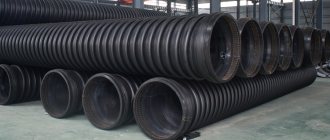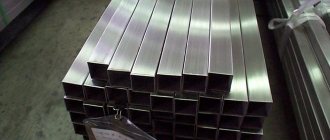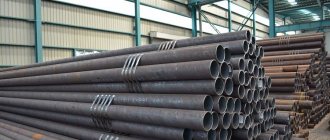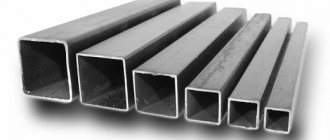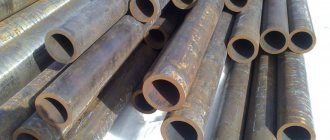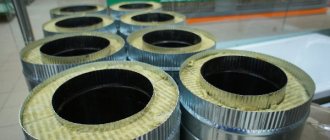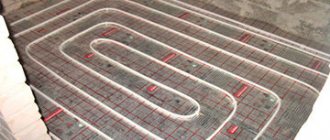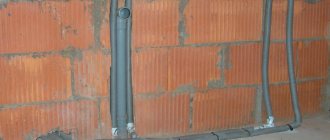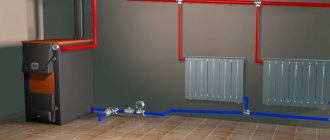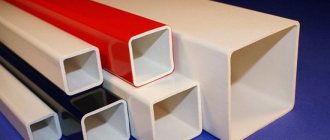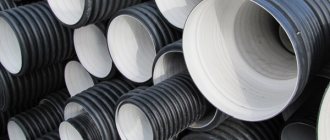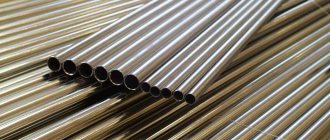At the end of the twentieth century, a sharp acceleration in scientific and technological progress led to the massive emergence of new technologies and materials. One of these new progressive building materials is double-walled corrugated pipe.
We welcome our regular reader and offer him information about durable double-wall corrugation, which is indispensable when installing wires, pipelines, cables, fiber optic communication lines in the ground, when pouring into concrete walls and floors.
Device
A double-wall pipe consists of two layers - an internal smooth one and an external corrugated one. The outer shell is corrugated - during the manufacturing process its cross-section changes variably with a certain step. The inner layer is a flexible pipe with a smooth shell, which makes it easier to pull wires and cables through the pipe and at the same time hermetically seals the interior from moisture.
Specifications
This type of pipe is both easy to bend and yet maintains strength and integrity through multiple cycles of bending, compression, tension, or combinations thereof. The ribbed surface of the corrugated shell simultaneously gives the corrugated pipe strength and at the same time increases the resistance to deformation during bending.
Technical characteristics of double-layer corrugation:
- High resistance to deformation, crushing, and tearing.
- Light weight.
- Durability.
- Possibility of sealing the protected communication from water.
- Chemical inertness.
- Resistance to aggressive environments and biological factors.
- Non-flammability of metal, polyvinyl chloride corrugation.
- Corrosion resistance (metal has less than plastic, but you can count on 20 years of service when laid underground). The big advantage of plastic products is their resistance to corrosion.
Purpose
Double-wall corrugated pipes have gained great popularity in various fields:
- assembly of electrical networks, electrical communications;
- installation of pipes through concrete screeds, brick foundations;
- production of sewer channels, drainage drains;
- installation of transport hubs.
Corrugated products are not suitable for the manufacture of pipelines operating at high temperatures and pressure. This is due to the technical characteristics of the material.
Application area
Installation of electrical networks, communication lines and telecommunications
Corrugated double-wall pipe is intended for underground installation of electrical networks, communication lines and telecommunications. The corrugation protects power and communication cables from seismic and force effects of the soil at the site where the cable is laid, as well as from soil water and the chemical effects of aggressive soil components. Protection for cable ducts from moisture is ensured by the use of appropriate fittings (couplings) and sealing seals.
Of particular note is the need for additional protection of cables in earthquake-prone areas. In addition, the corrugation will preserve the cable during excavation work, cable replacement, construction and installation work (for example, laying sewerage, drainage, water supply), and landscaping.
When installing multi-channel communication systems, flexible double-wall corrugation of small diameter is sometimes pulled into rigid double-wall pipes of large cross-section. There are pipes with several cells for pulling various cables.
To lay high-voltage cables in the ground, pipes with an outer layer of red color are used - this makes it easier to notice communications during excavation work. For low-voltage communication networks, blue corrugation is used. Black pipes are for general purpose.
Construction
Double-walled products are widely used in construction for pouring into reinforced concrete walls, floors and covering cables and wires for power supply, communications, heating, telecommunications, and the Internet.
Corrugation is used when laying electrical networks outside the building, in attics and basements, in damp and wet rooms. In principle, corrugation should be used when laying communications behind suspended ceilings and false walls made of plasterboard, when laying openly, when laying on a combustible base, but double-layer corrugation is usually not used in these cases because of the higher price compared to single-layer.
In some cases, corrugated pipe is used to strengthen underground external communications (cold and hot water), made of plastic pipes and laid in soils with the possibility of settlement. Nowadays, two-layer corrugations, including those of large diameter, are also used for sewerage systems.
Installation of a “warm floor” heating system pipeline without protecting the heating pipe with a durable corrugated pipe is not permissible. For floor heating, not very strong flexible plastic pipes are used - they are very sensitive to mechanical loads and require a protective cover.
It is impossible not to mention the modern equipment of bathrooms and kitchens - double-layer hoses are now installed to connect any toilet, faucet, shower sprayer, tank heater, gas stove, gas boiler or water heater.
Improvement
Perforated corrugated drains are used for the installation of drainage and storm sewer systems.
Transport hubs and communications
Large transport terminals are stuffed to capacity with all kinds of electrical networks, communication lines, remote control of equipment, video cameras, fire and burglary alarms. In any transport hub, be it an airport, a railway station, a seaport, communications when laid in the ground are subject to significant dynamic loads, sometimes comparable to an earthquake, and require reliable protection.
Types of corrugated pipes
Depending on the required installation conditions, the degree of maximum permissible load on a given type of product varies; they are distinguished:
- light, FL series. Maximum load 350 N per 5 cm. Used for open laying on floors, ceilings, walls inside buildings of any type. Optimal for false ceilings;
- heavy, FH series. Maximum permissible load 750 N per 5 cm. Used for laying and protecting under a layer of concrete in monolithic construction;
- super heavy. They allow a load of 1250 H. They are used for underground installation and in places with high safety requirements for wiring: children's institutions, hospitals, cinemas.
Each series can be performed with or without broaching inside the tubular channel. A broach, a metal wire with a diameter of 0.9 mm, is used to equip pipes to speed up the assembly process.
It is enough to connect the end of the wire to the end of the cable and pull it out from the other side. This solution allows you to reduce installation time by three times.
Types and features of corrugated pipes
Corrugated pipes are single-, double-layer, perforated (double-layer). There are thin-walled ones - for open wiring; with a reinforced wall (usually two-layer). Corrugation with a reinforced wall is intended for installation of communications in the ground or concrete. There are flexible and rigid corrugated pipes. There are light, heavy and extra heavy varieties.
Flexible
Flexible pipes are usually thin-walled and supplied in coils. Used for installation of open wiring or installation behind suspended ceilings or false walls.
Tough
The purpose of rigid corrugation is for installation of underground communications. Supplied in pieces, most often 6 m long. It has high strength. Double-layer corrugated pipes are usually all rigid.
Plastic
Plastic products are produced from polyvinyl chloride, high and low pressure polyethylene (LDPE and HDPE); polypropylene. The inner layer is usually made of more plastic PVD, the outer layer is made of more rigid PVC, HDPE, polypropylene.
Comparative characteristics
Steel is stronger than plastic. Therefore, double-layer corrugated pipes with a steel outer layer are used to fill heated floors. Stainless steel, in principle, can last almost 100 years (but will the inner layer of plastic last that long?), but stainless steel is expensive.
Steel can operate at both low and elevated temperatures. Cold resistance for PVC is not lower than -10°C, for polypropylene - up to -10°C and lower, for PE - up to -70°C. Heat resistance: PVC and PE - no higher than +40°C, for polypropylene - up to +95°C. The strength of PVC is two times higher than that of PE and polypropylene, and reaches 30-50 MPa at break. Only PVC is resistant to ultraviolet radiation.
Standardization of product parameters
Until 2014, corrugated electrical pipes were produced in accordance with GOST 50827 of 1995. Today, the main regulatory document for products is GOST 32126.1 of 2013. Many manufacturers, when producing pipes for this purpose, use technical specifications that determine the main characteristics of the product and do not contradict GOST standards.
Corrugated pipe can be made of non-flammable low-density polyethylene or polyvinyl chloride. The bay may contain 15, 25, 100, 20 or 50 meters of communications.
Note! The pipe is able to maintain its characteristics in dusty, dirty, and damp rooms for a long time.
The dimensions of PVC products are given in the table.
Table 1
| Inner diameter, *10 mm | Outer diameter, *102 mm | Pipe length in coil, m |
| 1,07 | 0,16 | 100 or 50 |
| 1,41 | 0,20 | 100 or 50 |
| 1,83 | 0,25 | 50 or 25 |
| 2,43 | 0,32 | 50 or 25 |
| 3,25 | 0,40 | 20 |
| 3,96 | 0,50 | 15 |
| 5,06 | 0,63 | 15 |
Advantages and disadvantages
The advantages of a double-layer corrugated pipe include all technical characteristics (see above), as well as:
- Easy and simple installation.
- Low weight facilitates transportation and installation.
- Durability - plastic, in the absence of ultraviolet radiation, can lie in the ground for 50 years or more.
- Steel corrugation in a dry room can also last for 50 years.
- Sufficient chemical resistance (and inertness).
- Tired and PVC – UV resistant.
- Safety for humans and animals, environmental friendliness.
- affordable price.
- Easy dismantling; possibility of repair; Possibility of reuse after careful dismantling.
Flaws:
- Steel products are susceptible to corrosion.
- Plastic (except PVC) are not resistant to ultraviolet radiation.
- The strength of plastic corrugation is lower than that of metal.
- Steel shells conduct electricity, and if the protected wires are damaged, they can cause electrical injury.
Advantages of PVC corrugated pipes
Corrugated pipes made of polyvinyl chloride have a number of positive qualities:
- not being conductors of electric current, they eliminate the possibility of injury if the cable’s own insulation is damaged.
- Resistant to corrosion and moisture.
- Non-flammable, do not require grounding.
- Chemical inertness.
- Waterproof.
- Protect the cable from various types of damage.
- Wide operating temperature range.
- Service life with preservation of performance qualities is at least 50 years.
- They are used in the reconstruction of old buildings and the construction of new ones.
- Environmentally friendly material.
- Problems with wiring located in the corrugation cavity can be quickly eliminated.
Products according to GOST 50827-95 are supplied in convenient for transportation coils of 100, 50, 25 and 15 meters. For a long time, they do not change their working properties when stored in dusty, damp rooms.
Tips for choosing
Buy a product with a certificate and inspect the product before purchasing - dents and cracks indicate that this product is not worth taking. The main thing is to choose a pipe suitable for the material: plastic corrugation - for installation in the ground and damp basement; UV-resistant - for laying on the wall of a house; steel - for pouring into a warm floor. Almost any kind is suitable for installation in the walls of dry rooms. It should be kept in mind that when naming a pipe size, it refers to the outer diameter of the pipes.
Popular manufacturers
Corrugated double-layer pipe is produced in each region. When choosing, you should take a closer look at the assortment and manufacturers and rely on reviews on the Internet. Imported products are more expensive and possibly of higher quality (if they are not fake). But domestic manufacturers are also not cut out for it - they will provide both quality and a lower price.
The most famous manufacturers of two-layer corrugated pipes in Russia: DKS CJSC - Dielectric Cable Systems, Politek, Poliplastik, Rospipe LLC, Uponor CJSC, Vavin LLC.
Nuances and subtleties of installation
Using corrugation for home repair work is quite accessible even for a novice craftsman.
Installation of corrugation in the house
You will need the following tools and materials:
- An electric drill/screwdriver with appropriate drills – it’s better to have two in one, otherwise you’ll have to climb up the stepladder again.
- Stepladders, scaffolding, “goats”.
- Dowels - the most popular - 4.5x40 mm. For weak plaster (lime plaster in old houses), it is better to take longer dowels - 6x60 mm, sometimes even 6x80 mm.
- Special clips of the required diameter.
- Actually a corrugated sleeve.
- Mounting boxes with holes corresponding to the diameter of the corrugation.
- If pipes are laid inside the box, clamps are used.
- To lay the grooves you will need a groove cutter, alabaster (plaster), and a spatula.
- Wire cutters.
- Bulgarian.
Before installing the corrugation, a wire is pulled into it using a special probe (wire).
Holes are drilled in the walls for the dowels, the clips (or steel clamps in the channels) are mounted using the dowels, and they are snapped into the pipe clips. The ends of the pipes are inserted into the installation and distribution boxes through special holes. It is better to cut pipes with a grinder.
In fines (this type of work is rarely used, because electrical wiring can be installed in the walls without a corrugated hose), a pipe is laid, sealed with gypsum mortar, then the entire fine is sealed. Boxes are also smeared into the wall.
When running wires behind drywall, flex pipes are laid on metal supports or the ceiling. On the ceiling, it is recommended to suspend the pipe from supporting structures using clamps.
Laying plastic corrugation in the ground
For this work you will need:
- Shovels – shovel and bayonet.
- Tamping.
- Crushed stone and sand.
- Corrugation; couplings; seals; silicone sealant.
- Grinder with cutting discs.
- The procedure for laying pipes in the ground.
- A ditch of the required depth is dug.
- Fine crushed stone is poured in a layer equal to the diameter of the pipe, but not less than 10-15 cm. It is compacted.
- Sand is poured into a layer of 10-15 cm at the bottom of the ditch, compacted, and spilled with water.
- If a corrugated cable or wires are being laid, then before laying it is necessary to tighten the wires or cable into the pipe using a probe (a wire pulled through the pipe).
- The pipe is being laid; The joints are connected using special couplings with seals.
- The seals are coated with silicone.
- Covered with sand. A layer of 10-15 cm. The sand is lightly compacted and spilled with water.
- The earth is falling asleep.
